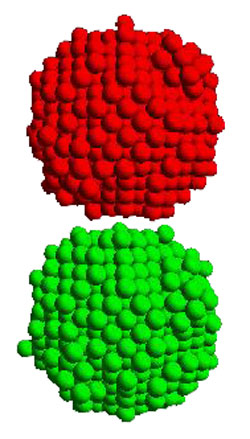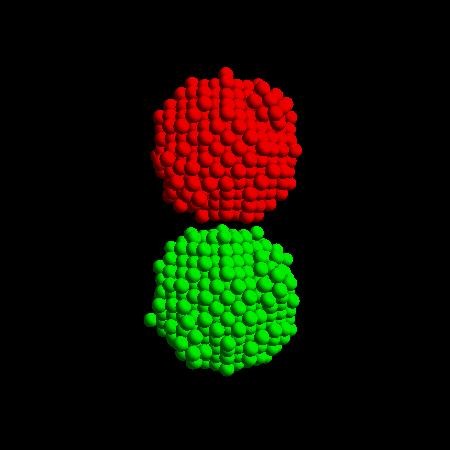Super Rebound
In collisions between two deformable or sticky objects, some or all of the initial energy is usually lost to heat. But computer simulations of nanocluster collisions, as described in the March Physical Review E, show that thermal fluctuations in the tiny projectiles can cause them to rebound with more kinetic energy than they started with. This energy boost would seem to violate the second law of thermodynamics, which bans heat from being turned directly into energy of motion. But for such small objects, the second law doesn’t necessarily hold. The researchers believe their work might apply to collisions of microscopic dust particles in space and to techniques in nano-device fabrication.
When two objects collide, the coefficient of restitution, or COR, is the ratio of the speed of separation after the collision to the initial speed of approach. A perfectly elastic collision will have a restitution coefficient of one, but almost all macroscopic collisions are inelastic, with coefficients less than one. A golf ball dropped on a concrete floor, for example, will bounce with a COR of around 0.8, and it can never be greater than one–despite golfers’ dreams–because some of the kinetic energy always goes into heating the ball.
But nanometer-sized objects are different, according to the simulations of Hiroto Kuninaka of Chuo University in Tokyo and Hisao Hayakawa of Kyoto University. Researchers are interested in so-called nanoclusters, in part, because they can be deposited on a substrate to create thin films for uses in technology. Kuninaka and Hayakawa have now combined elements from two types of collision studies: those that accounted for many atoms inside a particle but simulated high-speed impacts, and those that treated the particles as macroscopic, deformable spheres, as in studies of granular materials like sand.
The team ran several simulations starting with two identical clusters that each contained several hundred atoms. The collisions were head-on and relatively slow, at speeds slightly less than the typical thermal velocity at which the bound atoms jostled around inside their clusters. They didn’t need to specify the type of atoms in the simulations, but as an example, if they happened to be argon atoms, the cluster temperature would be set at 2 Kelvin, and the collision speed would be around 10 meters per second.
When the researchers varied the clusters’ cohesion–the attraction between clusters–they found that highly cohesive clusters clung together like pieces of clay, whereas less cohesive ones bounced apart like billiard balls. Much of these results agreed with recent theoretical predictions for small, macroscopic grain collisions [1] except that below a certain threshold of cohesiveness some of the simulated events displayed a COR greater than one and as high as 1.05. The fraction of these anomalous rebounds increased with the cluster temperature. “When the temperature increases, more and more vibrating modes are excited,” Kuninaka says. These vibrations can sometimes give an extra kick to the collision, like a gymnast pushing off the pummel horse to get a greater lift.
The transfer of energy from random internal motion of the atoms to the movement of the whole cluster creates a decrease in entropy and therefore an apparent violation of the second law of thermodynamics. But that’s OK at small scales. “In the nano-world, thermal fluctuations are very important and may be of the same order of magnitude as the ‘regular’ quantities,” says Nikolai Brilliantov of the University of Leicester in England. In rare cases, the vibrations may boost the outgoing particles’ speeds, but in other instances the fluctuations will dampen the rebound. Averaged over a large number of collisions, the entropy will increase, as the second law demands.
The modeling of nanoclusters and their collisions has relevance to nanotechnology as well as the formation of planets, in which the first steps involve accreting cosmic dust particles together into bigger and bigger grains. “This is a very interesting and important contribution to the subject, especially because it links the traditional continuum mechanics of macro-bodies with the new area of nano-mechanics,” Brilliantov says.
–Michael Schirber
Michael Schirber is a Corresponding Editor for Physics Magazine based in Lyon, France.
References
- N. V. Brilliantov, N. Albers, F. Spahn, and T. Pöschel, “Collision Dynamics of Granular Particles with Adhesion,” Phys. Rev. E 76, 051302 (2007).
More Information
movies of nanocluster collisions by Kuninaka and Hayakawa
Related Focus stories: Nanoparticles Stick a Perfect Landing (2008) and Getting an Extra Bounce (2004)





